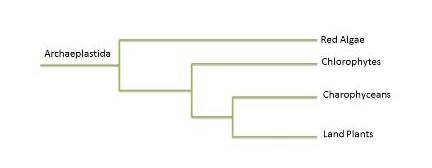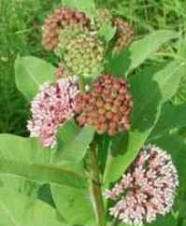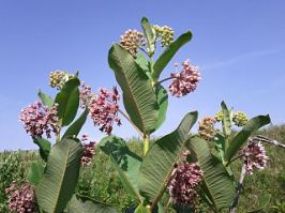Classification of Asclepias syriaca
Domain- Eukarya- This organism has a true nucleus and
membrane-bound organelles
Kingdom-
Plantae-This organism has cell walls containing cellulose and
undergoes photosynthesis
Phylum- Magnoliophyta (Angiosperms)-This organism is a flowering
plant and has protected seeds
Class- Magnoliopsida-This plant is a dicot, meaning the seed has
two coverings, the flower petals are
in groups of 4 or 5,
the veins are netlike, and there is one main root.
Order- Gentianales-This plant has leaves that are opposite or
whorled.
Family- Apocynaceae -This plant is a herb that is Native to
America with white sap
and latex within.
Genus- Asclepias-This plant is one of the milkweed
species.
Species- Asclepias syriaca-This plant is a broad-leaved
perennial herb with
pink or purple flowers that are in umbels. The seeds are in follicles.
This
milkweed species is known
as common milkweed; it has
a very large habitat range.
The Latin word Asclepias translates into English as "medicinal herb", indicating that the genus Asclepias has medicinal uses. To learn more about the medicinal uses of milkweed, visit http://medicinalherbinfo.org/herbs/Milkweed.html.
Phylogeny of Asclepias syriaca
This phylogenetic tree shows that land plants are derived from the super-group archaeplastida. Land plants are most closely related to charophyceans, chlorophytes (both of which are green algae), and red algae. This tree is derived from molecular evidence and similarities between the plastid DNA sequences and structure.

science.kennesaw.edu/~jdirnber/Bio2108/Lecture/Lec
Biodiversity/28_Labeled_Images/28_03eArchaeplastPhylo-L.jpg
This more specific phylogenetic tree is based on molecular
evidence of ten different species of Asclepias. In each
species, three different sequences of DNA were analyzed. They were "noncoding,
plastid DNA
regions" that included rpl16 intron, trnC-rpoB spacer and trnS-trnG spacer/trnGintron
(Agrawl and Fishbein, 2008).

http://www.pnas.org/content/105/29/10057.full
Go to the habitat page next or return home.

 wikimedia
wikimedia